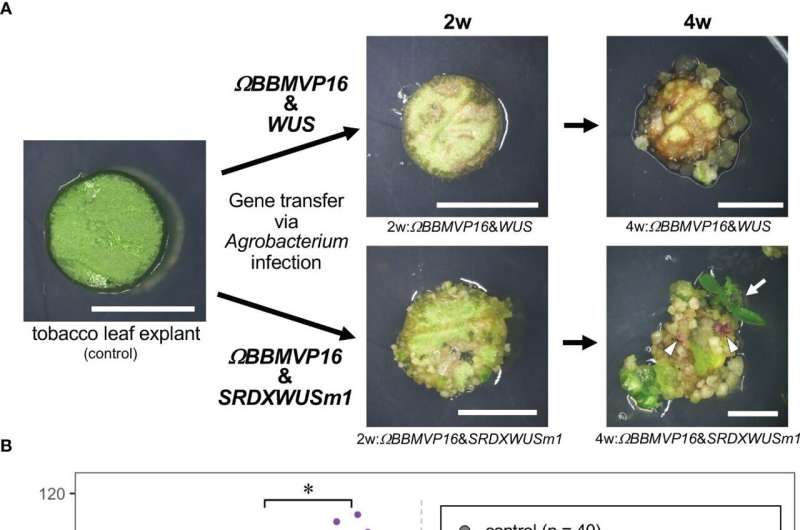This article has been reviewed according to Science X's editorial process and policies. Editors have highlighted the following attributes while ensuring the content's credibility:
fact-checked
peer-reviewed publication
trusted source
proofread
Researchers develop genetic plant regeneration approach without the application of phytohormones

For ages now, plants have been the primary source of nutrition for animals and mankind. Additionally, plants are used for the extraction of various medicinal and therapeutic compounds. However, their indiscriminate use, along with the rising demand for food, underscores the need for novel plant breeding practices.
Advances in plant biotechnology can address the problems associated with food scarcity in the future by enabling the production of genetically modified (GM) plants with higher productivity and resilience to the changing climate.
Naturally, plants can regenerate an entire new plant from a single "totipotent" cell (a cell that can give rise to multiple cell types) through dedifferentiation and redifferentiation into cells with various structures and functions. Artificial regulation of such totipotent cells through plant tissue culture is widely used for plant conservation, breeding, generation of GM species, and scientific research purposes.
Conventionally, tissue culture for plant regeneration requires the application of plant growth regulators (PGRs), such as auxins and cytokinins, to control cell differentiation. However, optimum hormone conditions can vary significantly with plant species, culture conditions, and tissue type. Therefore, establishing optimum PGR conditions can be time-consuming and laborious.
To overcome this challenge, Associate Professor Tomoko Igawa, along with Associate Professor Mai F. Minamikawa from Chiba University, Professor Hitoshi Sakakibara from the Graduate School of Bioagricultural Sciences, Nagoya University, and Expert Technician Mikiko Kojima from RIKEN CSRS, have developed a versatile method of plant regeneration by modulating the expression of 'developmental regulator' (DR) genes which control plant cell differentiation.
Giving further insights into their research work published in Frontiers in Plant Science, Dr. Igawa says, "Instead of using external PGRs, our system uses the DR genes, which are involved in development and morphogenesis, to control cellular differentiation. The system utilizes transcription factor genes and resembles induced pluripotent cell generation in mammals."
The researchers ectopically expressed two DR genes, namely—BABY BOOM (BBM) and WUSCHEL (WUS) from Arabidopsis thaliana (used as the model plant), and examined their effects on the differentiation of tobacco, lettuce, and petunia tissue cultures. BBM encodes a transcription factor that regulates embryonic development, while WUS encodes a transcription factor that maintains stem cell identity in the shoot apical meristem region.
Their experiments revealed that the expression of Arabidopsis BBM or WUS alone was insufficient to induce cell differentiation in tobacco leaf tissue. Conversely, co-expression of functionally enhanced BBM and functionally modified WUS induced an accelerated and autonomous differentiation phenotype.
The transgenic leaf cells differentiated into calli (a disorganized mass of cells), greenish organ-like structures, and adventitious shoots in the absence of PGR application. Quantitative polymerase chain reaction (qPCR) analysis (a technique used to quantify gene transcripts) revealed that the expression of Arabidopsis BBM and WUS was associated with the formation of transgenic calli and shoots.
Given the key role of phytohormones in cell division and differentiation, the researchers went on to quantify the levels of six phytohormones, namely—auxins, cytokinins, abscisic acid (ABA), gibberellins (GAs), jasmonic acid (JA), salicylic acid (SA), and their metabolites in the transgenic plant cultures. Their findings revealed that the levels of active auxins, cytokinins, ABA, and inactive GAs increased as cells differentiated to form organs, highlighting their role in plant cell differentiation and organogenesis.
Furthermore, the researchers used transcriptome by RNA sequencing (a technique used for qualitative and quantitative analysis of gene expression) to assess the gene expression patterns in the transgenic cells showing active differentiation. Their results suggested that genes related to cell proliferation and auxins were enriched among the differentially upregulated genes.
Further validation using qPCR revealed that four genes were upregulated or downregulated in the transgenic cells, including those regulating plant cell differentiation, metabolism, organogenesis, and auxin response.
Overall, these findings shed light on the novel and versatile approach to plant regeneration without the need for externally applying PGR. Moreover, the system used in this study has the potential to advance our understanding of the fundamental processes of plant cell differentiation and improve the biotechnological breeding of useful plant species.
Dr. Igawa says, "The reported system can improve plant breeding by providing a tool to induce cellular differentiation of GM plant cells without PGR application. Therefore, in societies where GM plants are accepted as products, it would accelerate plant breeding and reduce associated production costs."
More information: Yuka Sato et al, Autonomous differentiation of transgenic cells requiring no external hormone application: the endogenous gene expression and phytohormone behaviors, Frontiers in Plant Science (2024). DOI: 10.3389/fpls.2024.1308417
Journal information: Frontiers in Plant Science
Provided by Chiba University





















